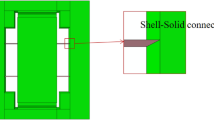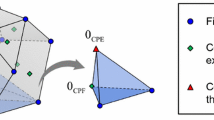Abstract
In this paper, a four-node \(C^{0}\) tetrahedral element for the modified couple stress theory is proposed. Since the governing equations are the fourth-order differential equations, the first-order derivative of displacement or rotation should be approximated by a continuous function. In the proposed element, nodal rotations are defined using the node-based smoothing technique. Continuous rotation fields are defined with the shape functions and nodal rotations. Both the displacement field and the rotation field are expressed solely in terms of the displacement degrees of freedom. The element stiffness matrix is calculated using the newly defined rotation field. To prevent the increase of calculation cost due to increase of the bandwidth of the stiffness matrix, the preconditioned conjugate gradient method is introduced. The performance of the proposed element is evaluated through various numerical examples.



















Similar content being viewed by others
References
Aifantis EC (1992) On the role of gradients in the localization of deformation and fracture. Int J Eng Sci 30(10):1279–1299. https://doi.org/10.1016/0020-7225(92)90141-3
Amanatidou E, Aravas N (2002) Mixed finite element formulations of strain-gradient elasticity problems. Comput Methods Appl Mech Eng 191(15–16):1723–1751. https://doi.org/10.1016/S0045-7825(01)00353-X
Askes H, Gutiérrez MA (2006) Implicit gradient elasticity. Int J Numer Methods Eng 67(3):400–416. https://doi.org/10.1002/nme.1640
Belytschko T, Lasry D (1988) A fractal patch test. Int J Numer Methods Eng 26(10):2199–2210. https://doi.org/10.1002/nme.1620261005
Chen JS, Yoon S, Wu CT (2001) A stabilized conforming nodal integration for Galerkin mesh-free methods. Int J Numer Methods Eng 53(2):435–466. https://doi.org/10.1002/nme.338
Choi JH, Lee BC (2018) A 3-node C 0 triangular element for the modified couple stress theory based on the smoothed finite element method. Int J Numer Methods Eng 114(12):1245–1261. https://doi.org/10.1002/nme.5784
Choi JH, Lee BC (2018) Development of a 4-node hybrid stress tetrahedral element using a node-based smoothed finite element method. Int J Numer Methods Eng 113(11):1711–1728. https://doi.org/10.1002/nme.5717
Choi JH, Lee BC (2018) Rotation-free triangular shell element using node-based smoothed finite element method. Int J Numer Methods Eng 116(6):359–379. https://doi.org/10.1002/nme.5928
Cook RD (2007) Concepts and applications of finite element analysis, 4th edn. Wiley, Hoboken
Cosserat E, Cosserat F (1909) Théorie des corps déformables. Herrman
Eringen AC (1983) On differential equations of non local elasticity and solutions of screw dislocation and surface waves. J Appl Phys 54(9):4703–4710. https://doi.org/10.1063/1.332803
Eringen AC, Suhubi ES (1964) Nonlinear theory of simple micro-elastic solids—I. Int J Eng Sci 2(2):189–203. https://doi.org/10.1016/0020-7225(64)90004-7
Feng H, Cui X, Li G (2016) A stable nodal integration method with strain gradient for static and dynamic analysis of solid mechanics. Eng Anal Bound Elem 62:78–92. https://doi.org/10.1016/j.enganabound.2015.10.001
Feng H, Cui X, Li G (2017) A stable nodal integration method for static and quasi-static electromagnetic field computation. J Comput Phys 336:580–594. https://doi.org/10.1016/j.jcp.2017.02.022
Fleck NA, Hutchinson JW (1993) A phenomenological theory for strain gradient effects in plasticity. J Mech Phys Solids 41(12):1825–1857
Fleck NA, Muller GM, Ashby MF, Hutchinson JW (1994) Strain gradient plasticity: theory and experiment. Acta Metall Mater 42(2):475–487. https://doi.org/10.1016/0956-7151(94)90502-9
Garg N, Han CS (2013) A penalty finite element approach for couple stress elasticity. Comput Mech 52(3):709–720. https://doi.org/10.1007/s00466-013-0842-y
Garg N, Han CS (2015) Axisymmetric couple stress elasticity and its finite element formulation with penalty terms. Arch Appl Mech 85(5):587–600. https://doi.org/10.1007/s00419-014-0932-0
He ZC, Li GY, Zhong ZH, Cheng AG, Zhang GY, Liu GR, Li E, Zhou Z (2013) An edge-based smoothed tetrahedron finite element method (ES-T-FEM) for 3D static and dynamic problems. Comput Mech 52(1):221–236. https://doi.org/10.1007/s00466-012-0809-4
Imatani S, Hatada K, Maugin GA (2005) Finite element analysis of crack problems for strain gradient material model. Philos Mag 85(33–35):4245–4256. https://doi.org/10.1080/14786430500363544
Koiter WT (1964) Couples-stress in the theory of elasticity. Proc K Ned Akad Wet 67:17–44
Kwon YR, Lee BC (2017) A mixed element based on Lagrange multiplier method for modified couple stress theory. Comput Mech 59(1):117–128. https://doi.org/10.1007/s00466-016-1338-3
Kwon YR, Lee BC (2018) Three dimensional elements with Lagrange multipliers for the modified couple stress theory. Comput Mech 62(1):97–110. https://doi.org/10.1007/s00466-017-1487-z
Lam DCC, Yang F, Chong ACM, Wang J, Tong P (2003) Experiments and theory in strain gradient elasticity. J Mech Phys Solids 51(8):1477–1508. https://doi.org/10.1016/S0022-5096(03)00053-X
Li E, He ZC, Xu X, Liu GR (2015) Hybrid smoothed finite element method for acoustic problems. Comput Methods Appl Mech Eng 283:664–688. https://doi.org/10.1016/j.cma.2014.09.021
Liu GR, Zhang GY (2009) A novel scheme of strain-constructed point interpolation method for static and dynamic mechanics problems. Int J Appl Mech 1(1):233–258. https://doi.org/10.1142/S1758825109000083
Liu GR, Zhang GY, Dai KY, Wang YY, Zhong ZH, Li GY, Han X (2005) A linearly conforming point interpolation method (LC-PIM) for three-dimensional elasticity problems. Int J Comput Methods 2(4):645–665. https://doi.org/10.1002/nme.2050
Liu GR, Dai KY, Nguyen TT (2007) A smoothed finite element method for mechanics problems. Comput Mech 39(6):859–877. https://doi.org/10.1007/s00466-006-0075-4
Liu GR, Nguyen-Thoi T, Lam KY (2009a) An edge-based smoothed finite element method (ES-FEM) for static, free and forced vibration analyses of solids. J Sound Vib 320(4–5):1100–1130. https://doi.org/10.1016/j.jsv.2008.08.027
Liu GR, Nguyen-Thoi T, Nguyen-Xuan H, Lam KY (2009b) A node-based smoothed finite element method (NS-FEM) for upper bound solutions to solid mechanics problems. Comput Struct 87(1–2):14–26. https://doi.org/10.1016/j.compstruc.2008.09.003
Liu GR, Nguyen-Xuan H, Nguyen-Thoi T, Xu X (2009c) A novel Galerkin-like weakform and a superconvergent alpha finite element method (S\(\alpha \)FEM) for mechanics problems using triangular meshes. J Comput Phys 228(11):4055–4087. https://doi.org/10.1016/j.jcp.2009.02.017
Liu GR, Xu X, Zhang GY, Gu YT (2009d) An extended Galerkin weak form and a point interpolation method with continuous strain field and superconvergence using triangular mesh. Comput Mech 43(5):651–673. https://doi.org/10.1007/s00466-008-0336-5
Ma X, Chen W (2013) Refined 18-DOF triangular hybrid stress element for couple stress theory. Finite Elem Anal Des 75:8–18. https://doi.org/10.1016/j.finel.2013.06.006
Ma X, Chen W (2014) 24-DOF quadrilateral hybrid stress element for couple stress theory. Comput Mech 53(1):159–172. https://doi.org/10.1007/s00466-013-0899-7
Mcfarland AW, Colton JS (2005) Role of material microstructure in plate stiffness with relevance to microcantilever sensors. J Micromech Microeng 15(5):1060–1067. https://doi.org/10.1088/0960-1317/15/5/024
Mindlin RD (1964) Micro-structure in linear elasticity. Arch Ration Mech Anal 16(1):51–78
Mindlin RD, Eshel NN (1968) On first strain-gradient theories in linear elasticity. Int J Solids Struct 4(1):109–124. https://doi.org/10.1016/0020-7683(68)90036-X
Mindlin RD, Tiersten HF (1962) Effects of couple-stresses in linear elasticity. Arch Ration Mech Anal 11(1):415–448. https://doi.org/10.1007/BF00253946
Nguyen-Thoi T, Liu GR, Lam KY, Zhang GY (2009) A face-based smoothed finite element method (FS-FEM) for 3D linear and geometrically non-linear solid mechanics problems using 4-node tetrahedral elements. Int J Numer Methods Eng 78(3):324–353. https://doi.org/10.1002/nme
Nix WD, Gao H (1998) Indentation size effects in crystalline materials: a law for strain gradient plasticity. J Mech Phys Solids 46(3):411–425
Papanicolopulos SA, Zervos A, Vardoulakis I (2009) A three-dimensional C1 finite element for gradient elasticity. Int J Numer Methods Eng 77(10):1396–1415. https://doi.org/10.1002/nme
Park SK, Gao XL (2008) Variational formulation of a modified couple stress theory and its application to a simple shear problem. Z Angew Math Phys 59(5):904–917. https://doi.org/10.1007/s00033-006-6073-8
Poole WJ, Ashby MF, Fleck NA (1996) Micro-hardness of annealed and work-hardened copper polycrystals. Scr Mater 34(4):559–564
Providas E, Kattis MA (2002) Finite element method in plane Cosserat elasticity. Comput Struct 80(27–30):2059–2069. https://doi.org/10.1016/S0045-7949(02)00262-6
Shu JY, King WE (1999) Finite Elements for Materials With Strain Gradient Effects. Int J Numer Methods Eng 44(January 1999):373–391. https://doi.org/10.1002/(SICI)1097-0207(19990130)44:33.0.CO;2-7
Soh AK, Wanji C (2004) Finite element formulations of strain gradient theory for microstructures and the C0–1 patch test. Int J Numer Methods Eng 61(3):433–454. https://doi.org/10.1002/nme.1075
Stelmashenko NA, Walls MG, Brown LM, Milman YV (1993) Microindentations on W and Mo oriented single crystals: an STM study. Acta Metall Mater 41(10):2855–2865. https://doi.org/10.1016/0956-7151(93)90100-7
Stölken JS, Evans AG (1998) A microbend test method for measuring the plasticity length scale. Acta Mater 46(14):5109–5115. https://doi.org/10.1016/S1359-6454(98)00153-0
Toupin RA (1962) Elastic materials with couple-stresses. Arch Ration Mech Anal 11(1):385–414. https://doi.org/10.1007/BF00253945
Watkins DS (2004) Fundamentals of matrix computations, 3rd edn. Wiley, Hoboken. https://doi.org/10.2307/2153000
Yang F, Chong ACM, Lam DCC, Tong P (2002) Couple stress based strain gradient theory for elasticity. Int J Solids Struct 39(10):2731–2743. https://doi.org/10.1016/S0020-7683(02)00152-X
Zervos A (2008) Finite elements for elasticity with microstructure and gradient elasticity. Int J Numer Methods Eng 73(4):564–595. https://doi.org/10.1002/nme
Zervos A, Papanicolopulos SA, Vardoulakis I (2009) Two finite-element discretizations for gradient elasticity. J Eng Mech 135(3):203–213. https://doi.org/10.1061/(asce)0733-9399(2009)135:3(203)
Zhang G, Lu H, Yu D, Bao Z, Wang H (2018) A node-based partly smoothed point interpolation method (NPS-PIM) for dynamic analysis of solids. Eng Anal Bound Elem 87:165–172. https://doi.org/10.1016/j.enganabound.2017.12.002
Zhang ZQ, Liu GR, Khoo BC (2012) Immersed smoothed finite element method for two dimensional fluid–structure interaction problems. Int J Numer Methods Eng 90(10):1292–1320. https://doi.org/10.1002/nme.4299
Zhao J, Chen W, Ji B (2010) A weak continuity condition of FEM for axisymmetric couple stress theory and an 18-DOF triangular axisymmetric element. Finite Elem Anal Des 46(8):632–644. https://doi.org/10.1016/j.finel.2010.03.003
Zhao J, Chen WJ, Lo SH (2011) A refined nonconforming quadrilateral element for couple stress/strain gradient elasticity. Int J Numer Methods Eng 85(3):269–288. https://doi.org/10.1002/nme
Zienkiewicz OC, Taylor RL, Zhu JZ (2005) The finite element method: its basis and fundamentals, 6th edn. Elsevier, Amsterdam. https://doi.org/10.1016/c2009-0-24909-9
Zybell L, Mühlich U, Kuna M, Zhang ZL (2012) A three-dimensional finite element for gradient elasticity based on a mixed-type formulation. Comput Mater Sci 52(1):268–273. https://doi.org/10.1016/j.commatsci.2011.02.026
Acknowledgements
GDS and JHC were supported by the National Research Foundation of Korea (NRF) grant funded by the Korea government (MSIT) (No. 2019R1C1C1003724) and Creative Materials Discovery Program through the National Research Foundation of Korea(NRF) funded by Ministry of Science and ICT (No .NRF-2019M3D1A1079229). GDS also acknowledges support by the KAI-NEET, KAIST, Korea.
Author information
Authors and Affiliations
Corresponding author
Additional information
Publisher's Note
Springer Nature remains neutral with regard to jurisdictional claims in published maps and institutional affiliations.
Rights and permissions
About this article
Cite this article
Choi, JH., Sim, GD. & Lee, BC. A four-node C\(^{0}\) tetrahedral element based on the node-based smoothing technique for the modified couple stress theory. Comput Mech 65, 1493–1508 (2020). https://doi.org/10.1007/s00466-020-01831-3
Received:
Accepted:
Published:
Issue Date:
DOI: https://doi.org/10.1007/s00466-020-01831-3




